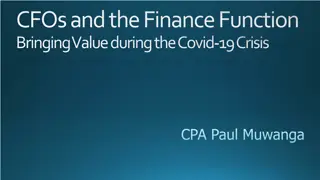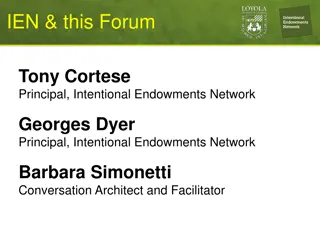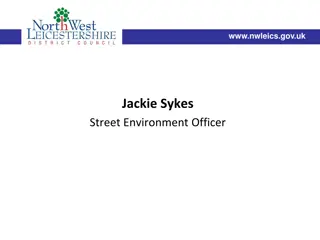M&A Considerations for Gov-Con CFOs
Explore buy-side M&A considerations specifically tailored for Government Contractor CFOs, covering financial due diligence, IT due diligence, GSA schedule due diligence, business combination accounting, and more. Aprio, a leading advisory firm, offers specialized services across various industries and capabilities including tax, advisory, audit, wealth management, and more.
Download Presentation

Please find below an Image/Link to download the presentation.
The content on the website is provided AS IS for your information and personal use only. It may not be sold, licensed, or shared on other websites without obtaining consent from the author.If you encounter any issues during the download, it is possible that the publisher has removed the file from their server.
You are allowed to download the files provided on this website for personal or commercial use, subject to the condition that they are used lawfully. All files are the property of their respective owners.
The content on the website is provided AS IS for your information and personal use only. It may not be sold, licensed, or shared on other websites without obtaining consent from the author.
E N D
Presentation Transcript
Before & After the Deal Buy-Side M&A Considerations for Gov- Con CFOs June 25, 2024 Disclaimer: We are not, by means of this presentation, rendering professional advice or services, and you should not take any action based on this presentation without first seeking professional advice tailored to your individual needs and circumstances
Aprio at a glance 2 60+ Languages Spoken 12 Industry Specialties Clients in 50+ Countries 2,100+ Team Members 35+ Services 193 Partners ! 900 Retirement Plans Team Members in 50 States & Internationally #30 In the U.S. $1.6 Billion in AUM 6 VC Investments Morison Global *As of March, 2024
We are advisors across industries, services and capabilities 3 Specialty Tax Employment Tax State & Local Tax Tax Credits & Incentives Income Tax & Estate Planning International Tax Transfer Pricing Tax Controversy Services Customs and Tariffs Global Mobility Digital Advisory Data and Analytics Blockchain Digital Transformation Risk Management Advisory Cybersecurity Advisory Information Assurance Business Applications (ERP) Sage, Intact, Unanet, NetSuite Practice Groups Advisory & Consulting Audit & Assurance Tax Wealth Management Managed Services Managed Services Client Accounting Payroll & HR Services Employee Benefit Solutions IT & Financial Staffing Indirect Tax Fractional CFO Financial Planning & Analysis Merchant Services State Compliance & Entity Management Business Performance Transaction Advisory Business Valuation Forensics and AML Technical Accounting Consulting Treasury Optimization Services Sustainability Services (ESG) Retirement Plan Services Industry Construction Financial Services Individual/High Net Worth Manufacturing & Distribution Nonprofit & Education Government Contracting Private Equity Professional Services Real Estate Restaurant, Franchise & Hospitality Technology & Blockchain International
4 Agenda Overview Financial Due Diligence Information Technology Due Diligence GSA Schedule Due Diligence Business Combination Accounting Wrap-Up
5 Identify key focus areas for financial due diligence in Gov-Con M&A deals Understand the basics of GSA Schedule due diligence Improve your knowledge of IT risks in an acquisition setting Explore how the purchase price in an M&A transaction is allocated to the assets acquired and liabilities assumed, including the valuation of intangible assets Learning Objectives
6 Bill Foote Partner, Transaction Advisory Services and Business Valuation Services 301.231.6299 william.foote@aprio.com Thank You! Greg Levins EVP, Digital Transformation and Cybersecurity Advisory 470.205.2859 greg.levins@aprio.com Jennifer Aubel Senior Manager, Government Contracting 301.231.6253 jennifer.aubel@aprio.com
8 Acquisition Process Before the Deal After the Deal Indication of Interest Funding and Closing Due Diligence Purchase Price Allocation Letter of Intent ERP Integration Continued Due Diligence and Negotiation Indirect Cost Rate Optimization Definitive Agreement Dispute Resolution Funding and Closing Business Combination Subsequent Accounting
9 Moving Parts General Government Contracting Valuation considerations Transaction tax structuring Working capital peg Earnout options Financing choices Escrows Management team transition Employment agreements Set-aside contracts Past performance Upcoming re-competes Pending awards and bid protests Terminations for convenience or for default DCAA audit status Cost accounting issues
10 Valuation Considerations Contracts Portfolio Financial Performance Workforce Technology Markets Served Contract Award Basis Contract Types Prime vs. Sub Backlog, Pipeline, Waterfall Revenue and Growth Profile Profitability Profile Management Team Employee Education / Certifications / Clearances Unique IP Proprietary Methods
11 Valuation Impact Example $5.6M EBITDA 6.50x Multiple $36.4M EV Management EBITDA $5.2M EBITDA 6.50x Multiple $33.8M EV Diligence- Adjusted EBITDA
12 Audience Participation #1 In Gov-Con M&A, how important is ERP platform integration to the overall success of the deal? a) Very important b) Somewhat important c) Not important
Financial Due Diligence
14 Financial Due Diligence Goals Comprehensive understanding of target s business from a financial perspective Fact-based analysis of target s historical financial information Objective view of target s normalized EBITDA and other financial indicators Investigate buyer preliminary concerns Flag risks and identify issues for definitive agreement Present information that will aid in buyer s decision-making process
15 Scope & Data Gathering FDD audit FDD looks beyond historical financials and GAAP measures AFS/RFS and FDD scope Historical period and periodicity FDD constituents Information flow FDD focus areas Contract revenue Contract margin Operating expenses Significant subcontractors Adjusted EBITDA Backlog, waterfall analysis Balance sheet Working capital
16 Contract Revenue Revenue recognition Revenue trends Revenue concentrations Bridge analysis Revenue categorization Contract Type Role Award Type POP End
17 Contract Margin Level Measure Trends Company-wide Gross profit/margin 12-month periods (FY, LTM) Line of business Contribution profit/margin Comparable YTD periods Contract-by-contract Monthly
18 Operating Expenses Government Contracting General Chart of accounts and mapping Trends, fluctuations Cost categories Fixed vs. variable costs Related party transactions Long-term commitments Accounting cutoff Indirect cost pools o Structure, number of o Historical period changes o Compatibility Allowability of costs Incurred cost submissions Indirect cost rate variances
19 Quality of Earnings (Q-of-E) Culmination of FDD analyses and procedures Adjusted EBITDA should reflect ongoing, normalized operations Start with reported revenue and EBITDA Arrive at adjusted revenue and EBITDA Adjusted EBITDA as central theme Valuation Financing Buyer forecast Significance of reported and adjusted EBITDA
20 Adjusted EBITDA Adjustments Illustration Reported revenue Due diligence adjustments Due diligence adjusted revenue 48,750 (200) 48,550 Revenue recognition One-time/non-recurring items Transaction expenses Discretionary items Out-of-period items Misclassified items Run-rate adjustments Net income Interest Taxes Depreciation & amortization Reported EBITDA Reported EBITDA % 3,175 225 1,240 375 5,015 10.29 Management adjustments Management adjusted EBITDA Management adjusted EBITDA % 588 5,603 11.49 Due diligence adjustments Due diligence adjusted EBITDA Due diligence adjusted EBITDA % (400) 5,203 10.72
21 Working Capital Current Assets Current Liabilities Working Capital Unlikely that a buyer would pay the same for a business with normal working capital as for one with deficient or excess working capital Debt-free, cash-free calculation Working capital peg Considerations for definitive agreement
22 Audience Participation #2 How confident are you about your organization's ability to evaluate an acquisition target's financial information? a) Very confident b) Somewhat confident c) Not confident
Information Technology Due Diligence
24 Enabling a Digital Organization Cybersecurity Digital Strategy Defining executable cybersecurity strategies, prioritization based on risk. Development of security architects, deployment of tools and processes, and support for ongoing security operations Where to Play / How to Win Digital Strategy Development Connecting Customers, Suppliers and Employees . Enabling Digital Technology Digital Management and Insights Data management, architecture and analytic enablement, business intelligence, descriptive analytics and data visualization, AI, machine learning, and data science, Insights as a service ERP, Cloud Enablement, DevSecOps, IT Financial Management, Systems Integration, Process Automation
IT Due diligence challenges 25 20 20+ + years years TECHNOLOGY EXPERIENCE we know what needs to happen when and what to look for. The experience and process to drive efficiency and address common IT due diligence challenges Hidden cost and risk: Distributed purchasing over time and across personnel often hides both costs and risks like reoccurring licensing fees for mission critical SaaS applications billed to employee credit cards. DRIVE EFFICIENT DISCOVERY proven methodology, templates and structures for data collection Confidentiality constraints: It s often hard to get the information from employees without breaching the confidentiality of the deal. LEVERAGE INDUSTRY SPENDING STANDARDS compare target s cost models to identify deviations that could flag risk Tight timelines: Reacting quickly to take advantage of market opportunities can time box due diligence activities, and in turn limit the depth of engagements. Opportunistic acquisition strategies: How a buyer s strategic vision will be realized can be limited by the resources in place to define the end game. This is common in roll up strategies. 20 20+ + years years CYBERSECURITY EXPERIENCE evaluate targets and their markets to assess the highest value security controls to the risk portfolio
Understanding the Full Scope of IT Maturity 26 IT Management Prioritize / align IT domains, define roles and responsibilities, and process effectiveness DATA DRIVEN IT MANAGEMENT Workforce Workforce resources planning to define how and where internal and external resources are engaged Cost and Budget Attaining the right degree of visibility for technology cost, and prioritization changes.
27 4 Service Delivery Options 1. Understand the Technology Baseline assessment of the technology program s solutions, design, and workforce. Examples include data centers, servers, hardware, software, user, client computing, locations, networking, disaster recovery, cloud services, complete security program, IoT, and vendors. 3. Building Repeatable Transitions Review transition plans the organization is currently executing. Define repeatable process for future M&A transactions that leverage reusable data collection and assessment processes to reduce time and cost for transactions. 2. Defining the Cybersecurity Risks Understand if the organization has potential cybersecurity risks. Aprio will review the existing state of technology and processes designed to protect the organization's information technology assets and data. 4. Defining a Digital Roadmap Analyze the long-term digital strategy for core technology service capabilities, develop technology blueprint for service delivery, create core operating models to support the tech portfolio, define vendor management program and create comprehensive cybersecurity protection program.
28 Audience Participation #3 Which of the following is not a factor in determining an organization's Information Technology Maturity? a) IT Management b) Digital / Technology Modernization c) Workforce d) Cost and Budget
GSA Schedule Due Diligence
30 Unique Risks with GSA MAS Contracts The more sales a contractor has on its MAS contract, the greater the financial impact of compliance failures! Price Reductions Clause (PRC) violations Use of unqualified labor on GSA task orders Overcharges on GSA orders Contract sales reporting and Industrial Funding Fee (IFF) remittance
31 Buy-Side Considerations Unexpected liabilities erode the value of your purchase MAS contract compliance is a niche area. Ensure your team understands the unique risks and nuances. Consider how to integrate the new MAS contract within your existing pricing and staffing structure Post-close, conduct an internal review within the Representations and Warranties Insurance (RWI) policy period
32 Things to Watch Out For MAS contract non-compliance puts the deal at risk! Is the target s MAS contract up to date, with competitive rates? Are there compliance skeletons in the target s closet? Has the target taken the time to conduct its own review? Has the target resolved findings? Or might that be the buyer s problem?
33 Audience Participation #4 A large software company held a GSA schedule contract, under which sales were negligible compared to the overall business. In 2012, an employee filed a FCA lawsuit alleging failure to make required pricing disclosures. How much did the U.S. and CA originally seek in damages and penalties for the alleged violations? a) $5.0M b) $27.0M c) $360.0M d) $1.2B
Business Combination Accounting
35 Business Combination Basics ASC Topic 805: Business Combinations Business Combination: a transaction or other event in which an acquirer obtains control of one or more businesses Acquisition method: assets acquired, and liabilities assumed recognized at fair value as defined in ASC 820: Fair Value Measurement Purchase consideration measured as the sum of the acquisition date fair values of cash consideration, contingent consideration, acquirer equity, liabilities assumed
36 Other Business Combination Considerations Acquisition-related costs Synergies Subsequent measurement and accounting Contingent consideration Impairment analysis PCC accounting alternatives ASU 2014-02, goodwill amortization, simplified impairment analysis ASU 2014-18, customer related intangibles, non-competes ASU 2021-03, impairment triggering events
37 Purchase Price Allocation Process Develop Purchase Consideration Analyze Business Enterprise Value Value Each Intangible Asset Calculate Residual Goodwill Reconcile IRR, WACC & WARA
38 Gov-Con PPA Examples Date Acquirer Target July-22 August-23 ICF International, Inc. Parsons Corporation SemanticBits, LLC Sealing Technologies, Inc. FV of total consideration transferred $ 216 100.0% $ 182 100.0% Identifiable assets acquired and liabilities assumed: Current assets Intangible assets: Customer-related Developed technologies Trade names and other Total intangible assets Other assets Total assets Current liabilities Other liabilities Total liabilities $ 19 8.7% $ 30 16.6% $ $ $ $ $ $ $ $ $ 63 29.2% 0.0% 0.5% 29.7% 0.2% 38.5% 4.7% 7.7% 12.5% $ $ $ $ $ $ $ $ $ 66 36.2% 4.4% 0.5% 41.1% 2.3% 60.0% 10.4% 1.0% 11.5% - 8 1 1 64 75 0 4 83 10 17 27 110 19 2 21 Goodwill $ 160 73.9% $ 94 51.4% Source: SEC filings
40 Recap Audit vs. Q-of-E Contract revenue bridge analysis Gross margin trends by contract Spotlight on Adjusted EBITDA Working capital should not be overlooked Mission critical SaaS applications may come with hidden costs Avoid the time box on IT due diligence Ensure the target s MAS contract is up to date Consider MAS contract structure alignment (target vs. buyer) Get ahead of business combination accounting --- don t wait until year-end
41 Bill Foote Partner, Transaction Advisory Services and Business Valuation Services 301.231.6299 william.foote@aprio.com Thank You! you! Thank Greg Levins EVP, Digital Transformation and Cybersecurity Advisory 470.205.2859 greg.levins@aprio.com Jennifer Aubel Senior Manager, Government Contracting 301.231.6253 jennifer.aubel@aprio.com

 undefined
undefined













































